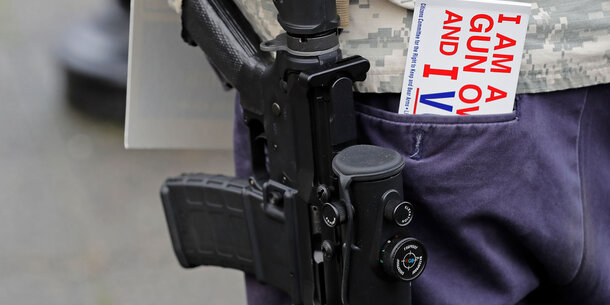Domestic abusers are among the last people in the world who should be carrying guns: women are five times more likely to die in a domestic violence situation if a gun is present. That’s why many states, and the federal government, prohibit people subject to domestic violence protection orders from having guns. And research shows that those laws work, reducing intimate partner homicide by up to 12 percent.
Earlier this year, however, a federal court struck down just such a law, sending shockwaves across the country. On November 7, the Supreme Court will hear oral arguments in that case, United States v. Rahimi. If the Court agrees that Zackey Rahimi’s Second Amendment rights were infringed, it would mark yet another expansion of Second Amendment rights under the Roberts court, with potentially devastating consequences for domestic violence victims. But the case also provides the Court an opportunity to diverge from the Second Amendment maximalism it has recently pursued.
Rahimi’s restraining order and shooting spree
Zackey Rahimi is a 23-year-old man who, it is safe to say, would not be gun rights advocates’ chosen litigant for the next big Second Amendment case. In December 2019, Rahimi got into an argument with his former girlfriend and the mother of their child in a Texas parking lot. Rahimi threatened to take away the child and, when the mother tried to leave, knocked her to the ground. He then dragged her to his car and shoved her inside. He noticed that a witness had seen the incident, so he retrieved a gun and fired at the witness. The mother was able to get away, after which Rahimi threatened to shoot her if she reported the abuse.
In February 2020, a Texas state court granted the former girlfriend a two-year protective order against Rahimi after a hearing in which Rahimi participated. Among other things, the court found that Rahimi had committed “family violence” that was likely to occur again. The protective order prohibited Rahimi from threatening, harassing, or approaching his former girlfriend or her family. It also barred him from possessing a firearm. In addition to these state-level restrictions, the Texas protective order automatically triggered a federal prohibition on possessing a gun.
Despite the protective order, Rahimi went on a shooting spree. On five separate occasions, Rahimi opened fire in fits of rage. One shooting followed a car accident he caused. Another was apparently triggered by anger at the declination of a credit card at a Whataburger drive-thru window. Another, caught on video, happened in close proximity to children.
Rahimi faces numerous criminal charges in Texas relating to these shootings, but at issue before the Supreme Court is his federal conviction for possessing firearms despite his domestic violence restraining order. Rahimi argued, and the Fifth Circuit Court of Appeals agreed, that the federal law — the automatic prohibition on gun possession triggered by the state protective order — violated Rahimi’s right to keep and bear arms.
The Bruen doctrine and resulting disparities in the lower courts
Before June 23, 2022, courts agreed that it was perfectly constitutional under the Second Amendment to disarm people who were subject to a domestic violence restraining order, like Rahimi. The Fifth Circuit, too, had upheld the law at issue in a case called United States v. McGinnis. But on June 23, 2022, in New York State Rifle & Pistol Association v. Bruen, the Supreme Court cast doubt on virtually all past Second Amendment decisions, including McGinnis.
In short, the Supreme Court declared that the legal standard that courts applied before Bruen was wrongheaded. Pre-Bruen, courts had pursued two steps in analyzing the constitutionality of gun regulations. First, whether the regulated weapons, people, or conduct was covered by the Second Amendment as historically understood. And, second, if so, whether the benefits to public safety outweigh the regulation’s burden on gun rights. Courts apply a similar approach in other constitutional rights areas, such as First Amendment free speech cases.
Bruen disavowed the part of the inquiry rooted in contemporary costs and benefits, instead instructing that the constitutionality of modern gun laws must be evaluated solely by comparison to our historical tradition of weapons regulation. The majority opinion proposed two “metrics” to guide that comparison — “how” and “why” historical and modern laws burden armed self-defense. That is, does the modern law regulate firearms for comparable reasons as the historical analogue, and does it do so in a comparable way. Courts were to determine whether the modern law was “analogous enough” to the historical regulatory tradition “to pass constitutional muster.”
Bruen’s new test was supposed to make Second Amendment law “more administrable” than the approach that it scrapped. However, it has failed to steer courts to consistent, predictable, and well-reasoned outcomes. To be sure, litigants have had more success challenging gun laws on Second Amendment grounds after Bruen than before. According to a forthcoming empirical analysis, 21 percent of all Second Amendment challenges have had at least partial success, compared to 9 percent between 2008 and early 2016.
But at the same time, courts are reaching wildly divergent results regarding the constitutionality of gun policies. They have disagreed about the constitutionality of banning people under felony indictment from acquiring new guns; prohibiting assault weapons, firearms with obliterated serial numbers, and large-capacity magazines; restricting self-manufactured “ghost guns”; disarming unlawful users of controlled substances; banning gun possession by people convicted of nonviolent felonies; barring guns in “sensitive places” such as places of worship, summer camps, urban mass transit, and Times Square; and prohibiting the purchase or carry of guns by people aged 18 to 20.
Rahimi adds the federal law prohibiting gun possession for those subject to domestic-violence restraining orders to the list — lower courts have reached opposite conclusions about whether the law is consistent with our tradition.
The Fifth Circuit’s decision and the difficulty of applying Bruen
The Fifth Circuit concluded that the federal law disarming Rahimi was an “outlier[] that our ancestors would never have accepted.” But in doing so, the Fifth Circuit demonstrated a challenge of applying Bruen to circumstances “our ancestors would never have” imagined.
How can courts use historical comparators to evaluate the constitutionality of contemporary gun laws involving firearms or places that did not exist at the founding, or which reflect recognition of problems (and, for that matter, people) the framers failed to address? What historical analogue, from a time before the existence of guns on subways or airplanes, should guide courts evaluating the modern prohibition on gun possession in subways or airplanes? Or, in the case of Rahimi, what historical analogues should guide evaluation of today’s domestic violence restrictions that were adopted specifically to break from a legal tradition that undervalued women’s lives?
Natalie Nanasi, a legal scholar and director of the Judge Elmo B. Hunter Legal Center for Victims of Crimes Against Women at Southern Methodist University, has observed that “when the Second Amendment was ratified in 1791, the lives of women bore little resemblance to those they lead today.” Women did not gain the federal right to vote until 1920 and were subjugated in numerous ways. They were not viewed as political or legal equals of men, and unsurprisingly, they were not affirmatively protected by anti-domestic violence laws.
As historians noted in a friend-of-the-court brief filed in Rahimi, women were not wholly without legal protection. The law of homicide applied against those who killed spouses in acts of domestic violence, and domestic abusers were sometimes required to post sureties that they’d forfeit if they didn’t act peacefully. The Fifth Circuit did not clearly consider such legal mechanisms in the domestic violence context, and a question before the Supreme Court will be how they should inform Bruen’s historical-analogical exercise. Another question will be how and whether courts should analogize to laws that we’d view as reprehensible today, such as those restricting the rights of Native Americans, slaves, and freed slaves. The Fifth Circuit considered those laws but viewed them narrowly in ways that distinguished them from domestic abusers subject to restraining orders. Other opinions, including one drafted by then-Judge Amy Coney Barrett, viewed those same laws as reflecting a principle that it’s constitutional to disarm “dangerous people,” a category that could encompass people subject to domestic violence restraining orders like Rahimi.
A chance to elaborate on Bruen, with lives in the balance
Rahimi provides the Supreme Court an opportunity to address confusion in the lower courts after Bruen. The majority opinion in Bruen did not offer guidance on basic issues that have arisen, such as how many policies are required for a “tradition,” at what level of generality courts should construe historical policies (an issue addressed in an friend-of-the-court brief submitted by Second Amendment scholars, including myself), and what to do when changes over time arguably render impossible a meaningful, predictable, and principled comparison of past to present.
At the same time, Rahimi will have acute ramifications for domestic abuse victims. The federal law being challenged was enacted in 1994 to address the relationship — well-documented now, but unappreciated at the founding — between guns and domestic violence. Research has shown that nearly half of women who are murdered in the United States are killed by an intimate partner and more than half of those murders involve a firearm. Every month, an average of 70 women are shot and killed by an intimate partner. If the Court agrees with the lower court and strikes down the federal law, it would be removing an important tool for combatting domestic violence today.






